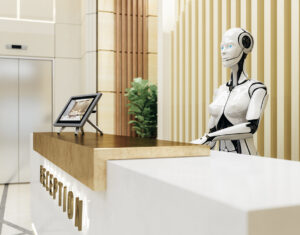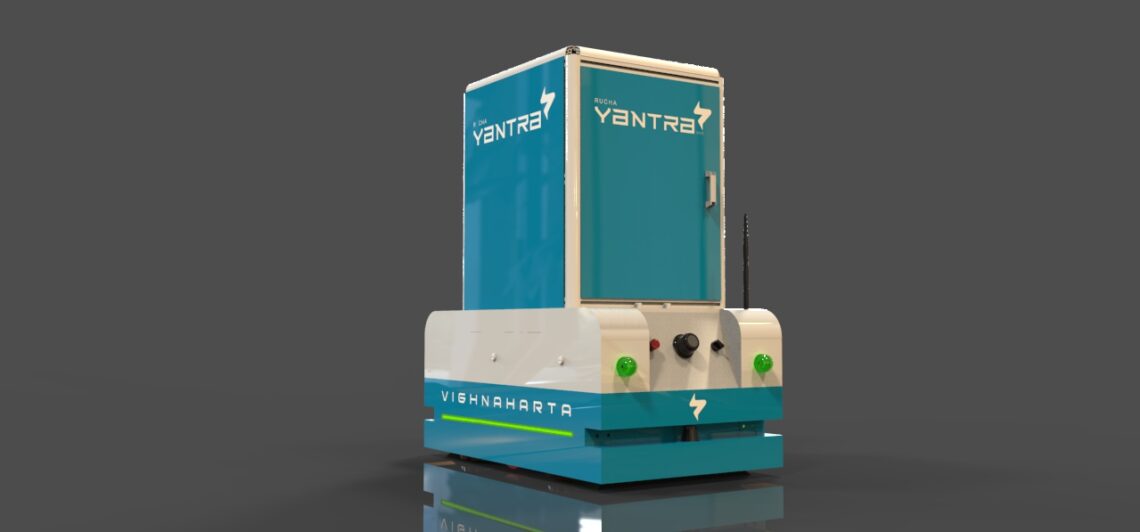Before we conclude the blog series on Robotics in Healthcare, we shall look at an essential type of robot taking the healthcare world by storm. Service robots relieve the burden on healthcare workers and paramedical staff by taking up routine logistical tasks. These robots can set up patient rooms, track supplies and file purchase orders, restock medical supply cabinets, and transport bed linens to and from laundry facilities. Delegating such tasks to robots helps the staff have more time for jobs that require human interaction and judgment.
The rise of service robots
The covid-19 pandemic has chang ed the way we live and work with each other. Sanitation requirements and social distancing measures have become the norm. However, few necessities remain: workplaces need to be cleaned, goods need to be delivered, people still require medical care, and so much more. For such tasks that can be automated without human involvement, companies have turned to service robots to mitigate the social gap created by the pandemic.
ed the way we live and work with each other. Sanitation requirements and social distancing measures have become the norm. However, few necessities remain: workplaces need to be cleaned, goods need to be delivered, people still require medical care, and so much more. For such tasks that can be automated without human involvement, companies have turned to service robots to mitigate the social gap created by the pandemic.
According to the World Robotics Service Robots 2020 report, the interest in service robots increased in 2019 and has continued to rise since the pandemic. In 2019, sales of service robots were 23.2 million. In 2020, the predicted increase was 15 percent. As compared to industrial robots, which saw a decrease in units sold by 12 percent in 2019, service bots are rising despite the ongoing crisis.
Trends driving the service robots industry
Now, let us look at how service robots are being deployed and what value they are adding to healthcare. Read on!
Sanitation:
With the onslaught of Covid-19, disinfecting hospitals and patient rooms became critical to avoid the spread of infection. Manual disinfection by hospital staff posed the risk of getting infected and spreading it to others. Throughout the pandemic, the use of disinfection robots has risen dramatically. Numerous disinfection robot types from diverse manufacturers were newly registered in 2020 worldwide. One of them was Yantra’s sanitation robot – check out how it works here, https://youtu.be/2VA72G0I-Uo. Yantra quickly realized the need for hospitals and the risks of infection for the staff and designed a robot that relieves them from disinfection.
Vitals check-up and promoting social distancing:
Nowadays, hospitals have started screening patients at the entrance for body temperature and covid-19 symptoms. Hospitals consider this process necessary to avoid infections for non-covid patients. However, if hospital staff or front-desk workers are delegated the task, it increases their risk of getting infected. Thus, to help limit human interaction, service robots have been developed to help automate the process. Screening robots help keep the distance between front desk workers and people.
For instance, Brigham and Women’s Hospital has deployed robots to collect patient data at hospital visits. In partnership with MIT researchers, the hospital has been using robots to remotely measure patients’ vital signs. It uses four cameras to measure skin temperature, breathing rate, pulse rate, and blood oxygen saturation at a distance of 2 meters. The doctor can remotely control the robot via a tablet, and the tablet allows for interactions with the patient.
Future medical care may become more automated to protect not just the patient but also the medical staff.
Intra-Transportation and Intra-Delivery:
As the number of covid-19 patients dramatically rose, the paramedical staff, such as the nurses, were heavily overburdened. Instead of providing care and support to their patients, an increasing amount of time began getting spent in delivering blood samples, bringing medications from the pharmacy, filing paperwork for each patient, etc.
dramatically rose, the paramedical staff, such as the nurses, were heavily overburdened. Instead of providing care and support to their patients, an increasing amount of time began getting spent in delivering blood samples, bringing medications from the pharmacy, filing paperwork for each patient, etc.
Service robots can add significant value here by relieving the staff from laborious, time-intensive activities. They can transport material from one point to another independently, file paperwork on the go, and deliver critical medications to patients on time. Moreover, such robots also reduce the interaction between employees and the patients leading to reduced risks of infection.
Yantra stayed ahead of the curve and launched a robot for the transportation of material within hospitals. Check out how Yantra’s robot, Vighnaharta, helps hospital transport and transport material ( https://youtu.be/Sn8e_ZCTMFQ).
Companion Bots to Enhance Interactions:
As hospitals try to minimize human-to-human interactions, especially those between infected patients and the staff, the need for providing alternate ways of companionship rises. Humans need companions; it is a basic necessity. Companion robots can serve the purpose well here.
Armenia-based company Expper Technologies has launched the robot Robin to interact with patients and provide companionship during their hospital stay. It is equipped with a cognitive learning system based on behavioral psychology and play therapy. It can remember conversations and recognize the patients’ facial expressions.
Thus, we have seen the rise of service robots and their impact on healthcare, as well as the four ways in which they are adding value. Indeed, in the coming years – bolstered by the pandemic – we shall see a more significant proliferation of service robots.
With its two robots directed at the healthcare industry, Yantra is actively developing solutions for the problems hospitals face today. Our team remains committed to making a difference. Stay tuned to our Knowledge Corner as we take up a different topic of interest in the next blog series.



